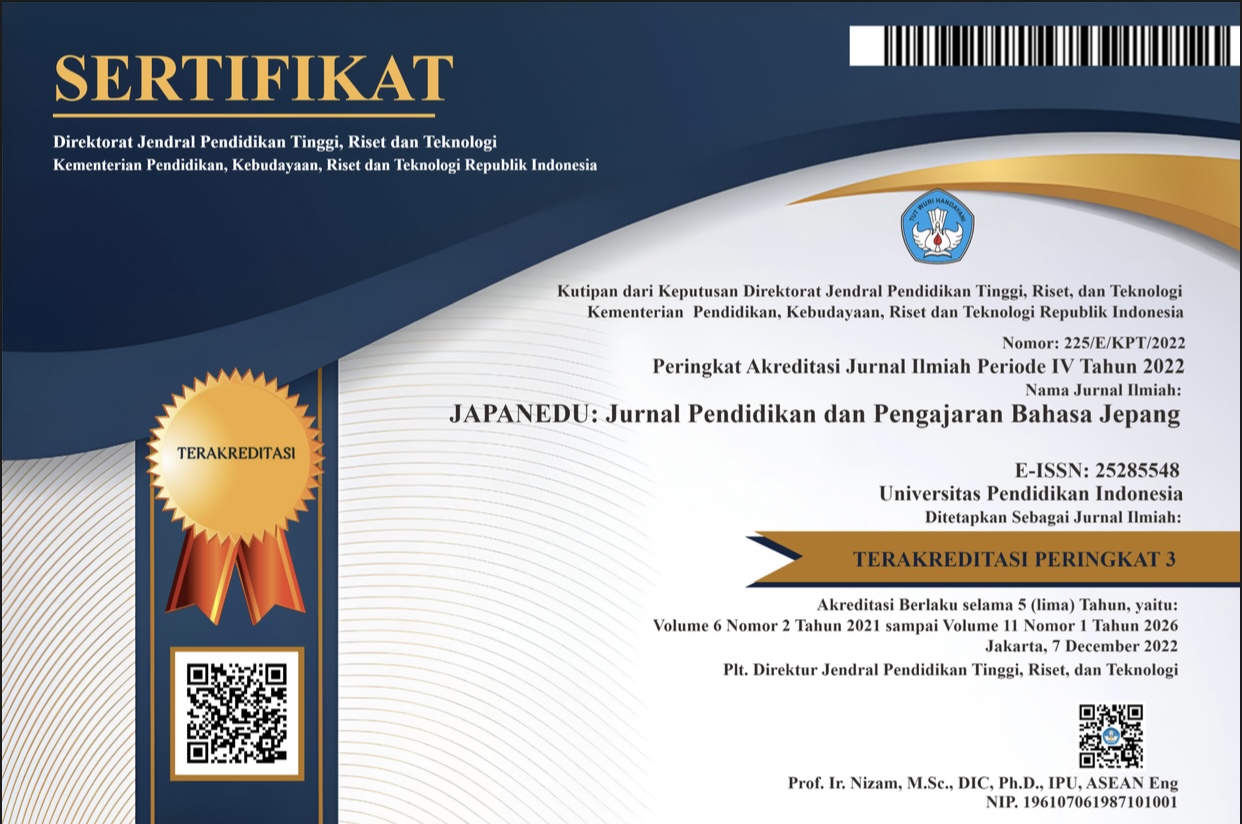JAPANESE ADVERTISEMENT FOR IMPROVING STUDENTS READING ABILITY
Abstract
Advertising is a form of communication that discloses information or messages and promotes the speaker's intent to his or her opponent. The language used in advertising is a language that is easy to understand and persuasive so that the opponent can speak as the speaker means. From advertisements in magazines, used for student learning in Dokkai 5. Dokkai or reading is a very important course for students to welcome the office work normally done by Japanese language graduates. In the office when working related Japanese often read documents and translate documents. In this research, using advertising media because it is usually written in large and striking letters.
To make the reading japanese learning more interesting Therefore, they needs to be approach that has never been done before with reading japanese advertisement from japanese magazine. Reading Japanese language is usually difficult because it consists of three figures namely Hiragana, Katakana and Kanji. So that become easier for students to reading through the selected advertising media.
This research is qualitative descriptive, and object of our study are students learning Japanese Language Education and Japanese Literature Brawijaya University who have passed JLPT N3 and already received materials about Dokkai 3 and Dokkai 4. Techniques data by purposive sampling and random sampling by using random numbers as much as 10% of the total population. In addition the results of this study will also describe motivation for students to improve their ability of reading. Therefore 指導 ポ イ ン ト (teaching points) as an effort to help the lecture to explain and possibility to use teach for higher education.
Keywords
Full Text:
FULLTEXT PDFReferences
Goldstein, Douglas. (2011). The Use of English In Japanese Advertising. International Journal
Hamzah B. Uno. (2013). Teori Motivasi dan Pengukurannya. Gorontalo: Bumi Aksara.
Yohani, Adisthi Marta, dkk. 2010. Tinjauan Sosiolinguistik Terhadap Bahasa Iklan Kosmetik Jepang.
Sugiyono. (2009). Metode Penelitian Pendidikan. Bandung: Alfabeta.
Tokyo Himawari. (Man Magazine). Terbit 23 Maret 2016
姫野、正子。(1998)。『ここからはじまる日本語教育』。ひつじ。
三牧、場子。(2003)。『日本語教授法を理解する本』。バベル・プレス。
洋子、阿部;etl。(2006)。『読むことを教える』。国際交流基金日本語国際センター。
石田、敏子。(1998)。『日本語教授法』大出版社書店。
岡崎、瞳。Etl。(2001)。『日本語教育における学習の分析とデザイン』。凡人社。
木村 , 宗雄. (1988). 教授法入門 (Dasar-dasar Metodelogi Bahasa Jepang Terjemahan Ahmad Dahidi dan 赤 羽 美 知 恵 ), The Japan Foundation
小林、ミナ。(1998)。『よくわかる教授法』。アルク。
DOI: https://doi.org/10.17509/japanedu.v3i2.10180
Refbacks
- There are currently no refbacks.
Copyright (c) 2018 JAPANEDU: Jurnal Pendidikan dan Pengajaran Bahasa Jepang

This work is licensed under a Creative Commons Attribution-ShareAlike 4.0 International License.
 Published by:
Published by: Department of Japanese Language Education, Faculty of Language and Literature Education
Universitas Pendidikan Indonesia
 Online ISSN: Online ISSN:2528-5548 |

JAPANEDU: Jurnal Pendidikan dan Pengajaran Bahasa Jepang (e-ISSN:2528-5548) lisenced under a Creative Commons Attribution-ShareAlike 4.0 Internasional (CC BY-SA 4.0)


